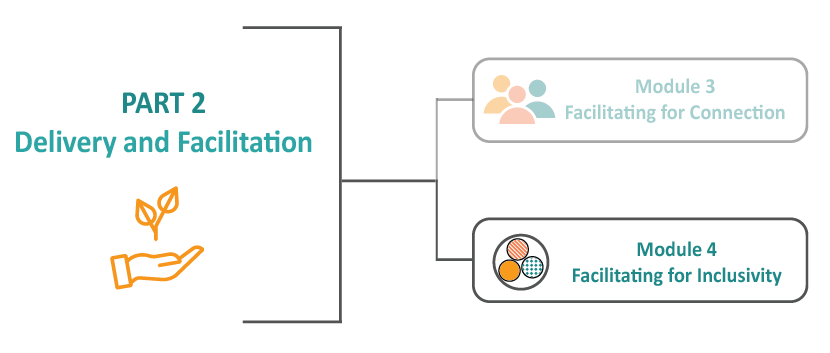Module 4: Facilitating for inclusivity
4.1 Module overview
Transcript (PDF)| Video length ~ 2 min.

Learning outcomes
What you can take away from this module:
- The ability to identify and apply principles of inclusivity, diversity, and/or equity to humanize how you facilitate your course.
- Confidence in how to navigate sensitive topics and create safe and brave spaces in online discussion with trauma-informed communication strategies.
This module sets out key principles and applicable strategies for facilitating an inclusive learning environment to help learners feel respected and connected to each other and engaged in course concepts/content, activities, and assessments as they learn during the term. Whether you are the designer and author of the virtual course you are teaching or not, this module will provide you with facilitation strategies that help to build an inclusive learning environment throughout the term, which do not require you to change the content or design of your course. If you do have control over the design of your course, we suggest that you start with Module 2 Designing for Inclusivity for foundational Key principles and Strategies in action that bake inclusivity into the design of your virtual course.
Concepts covered in this module include equity, diversity, decolonization, inclusion (EDDI) and sensitive (trauma-informed) strategies that set an example for learners and the tone for your course, including
- cultivating an inclusive community through modeling inclusive interactions and an accessible course structure;
- considering how academic conventions can be interrogated for inclusivity;
- implementing best practices for authentic and brave course discussions and how to address controversy in virtual learning environments; and
- identifying and dealing with content warnings, disclosures, and microaggressions.
The strategies outlined in the module provide tangible examples of what humanizing your online teaching can look like in practice and can be implemented by instructors or teaching assistants as a course is being offered, without the need to adjust course content.
Sections in this module
You can jump to any of the sections in this module by clicking the links below or using the left-side navigation menu.
4.2 Modelling inclusive behaviours during term
4.3 Inclusive facilitation practices
4.4 Trauma-informed approaches
4.5 Addressing microaggressions in virtual learning contexts
Strategies in action examples
Below are links to strategies and examples for those who would like to jump right to exploring humanizing principles and strategies in action applied in real virtual courses.
4.2 Modelling inclusive behaviours during term
- Strategies in action: Modelling EDII principles in interactions with learners
- Strategies in action: Implement common academic conventions with inclusivity in mind
- Strategies in action: Embracing inclusivity through an accessible teaching approach
4.3 Inclusive facilitation practices
- Strategies in action: Building course structures that create safe spaces for class engagement
- Strategies in action: Managing controversy in virtual class discussions
- Strategies in action: Considering facilitation practices that respond to the needs of your Indigenous learners
4.4 Trauma-informed approaches
- Strategies in action: Cultivating a safe space
- Strategies in action: Building safe spaces with collaborative charters
- Strategies in action: Providing content warnings
- Strategies in action: Additional strategies for facilitating sensitive topics
- Strategies in action: Responding to learner disclosures
- Strategies in action: Sexual violence disclosures
- Strategies in action: Disclosures from Indigenous learners
- Strategies in action: Respectful discussion of populations experiencing marginalization
4.5 Addressing microaggressions in virtual learning contexts
- Strategies in action: Recognizing and responding to microaggressions
Reflect and apply activities
Reflect and apply
Below are links to all the Reflect and apply activities for those interested in diving right into applying principles and examples to their own course design and teaching context.
4.2 Modelling inclusive behaviours during term
- Reflect and apply: Do academic conventions serve your learning outcomes?
- Reflect and apply: Course accessibility checklist and plan
4.5 Addressing microaggressions in virtual learning contexts
Going deeper resources
Going deeper
Below are links to additional resources on various topics for those interested in learning more about a particular topic.
4.2 Modelling inclusive behaviours during term
- Whose Land
- Native Land
- Beyond territorial acknowledgements
- ‘I regret it’: Hayden King on writing Ryerson University’s territorial acknowledgement
- 1.2 Virtual learning contexts and virtual learners,
- LMS templates:
- Brightspace: Brightspace HTML Template (version 3.0)
- Canvas: Humboldt State University: Designing your course with modules and pages
- Moodle: Moodle course templates
- Queen’s University, Brightspace: Create a course
- Trent University, Blackboard: Blackboard – Faculty – Template
- University of Toronto, Canvas: Example remote/online course template – University of Toronto
- University of Waterloo, Brightspace: Online course templates
- Creating Accessible Documents
- Web Accessibility for Designers
- Image Description
- Accessible Math
4.3 Inclusive facilitation practices
4.4 Trauma-informed practices
- Trauma-informed practices for post-secondary education: A guide (PDF)
- Respect, not censorship: Students weigh in on the trigger warning debate
- Trigger Warnings
- An introduction to content warnings and trigger warnings (PDF)
- Guidelines for talking about difficult topics in a remote course
- Responding to disclosures on campus
- Truth and Reconciliation in Post-Secondary Settings: Student Experience (PDF)
- Holding our ground: Indigenous student post-secondary persistence & early leaving (PDF)
- Talking complicity, breathing coloniality: Interrogating settler-centric pedagogy of teaching about white settler colonialism
4.5 Addressing microaggressions in virtual learning contexts

